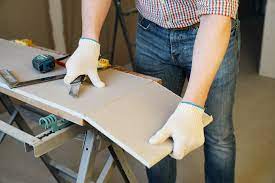I think you’re searching that Can You Cut Drywall with a Table Saw?
Well!
You’re on right place because we already have worked for you. Drywall, also known as gypsum board or sheetrock, is a commonly used building material for interior walls and ceilings. It is known for its ease of installation, affordability, and versatility.
When working on a construction or remodeling project that involves drywall, one of the key tasks is cutting the drywall to fit the required dimensions.
While there are several tools and methods available for cutting drywall, one question that often arises is whether it’s possible to cut drywall with a table saw.
In this article, we will explore the feasibility, safety considerations, and best practices for cutting drywall with a table saw.
Why Consider Using a Table Saw?
Table saws are powerful and precise cutting tools primarily designed for cutting wood, but they can also be used for other materials with the right blade and setup. There are a few reasons why someone might consider using a table saw to cut drywall:
- Precise Cuts: Table saws are renowned for their accuracy and ability to make straight and clean cuts. When cutting drywall, especially for intricate projects or when precise measurements are crucial, a table saw can be a valuable tool.
- Efficiency: Table saws are efficient and can cut through drywall quickly. This can save time on larger projects or when numerous cuts are required.
- Versatility: If you already own a table saw for woodworking or other purposes, the ability to use it for drywall cutting can make it a versatile addition to your toolkit.
- Straight Edges: Table saws are equipped with a flat table and a fence that ensures straight cuts. This is important when you need perfectly straight edges on drywall pieces for a seamless finish.
While a table saw can be a useful tool for cutting drywall, it’s essential to understand the considerations and safety precautions involved.
Safety Precautions
Before attempting to cut drywall with a table saw, it’s crucial to prioritize safety. Drywall cutting can create dust and debris, and there are risks associated with using power tools. Here are some safety precautions to keep in mind:
- Safety Gear: Always wear appropriate safety gear, including safety goggles or a face shield to protect your eyes, a dust mask or respirator to prevent inhaling dust, and hearing protection.
- Blade Selection: Choose the right blade for cutting drywall. A fine-toothed carbide-tipped blade designed for cutting non-ferrous materials is a good choice. Avoid using standard wood-cutting blades, as they can result in rough and uneven cuts.
- Secure Workpiece: Ensure that the drywall piece is securely supported and clamped to the table saw’s surface. This prevents the material from vibrating or shifting during the cut, reducing the risk of accidents.
- Keep Hands Away: Always keep your hands and fingers away from the blade. Use a push stick or push block to guide the drywall through the saw, maintaining a safe distance from the cutting area.
- Ventilation: Work in a well-ventilated area or use a dust extraction system to minimize dust exposure.
- Familiarize Yourself: If you’re not experienced with table saws, take the time to familiarize yourself with the tool and its operation. Follow the manufacturer’s instructions and guidelines.
Cutting Drywall with a Table Saw
Now that we’ve discussed the safety precautions, let’s walk through the steps of cutting drywall with a table saw:
- Measure and Mark: Begin by measuring the length you need to cut on the drywall sheet. Use a straightedge and a pencil to mark the cut line on the drywall’s surface.
- Set Up the Table Saw: Install the appropriate blade for cutting drywall on the table saw. Adjust the blade height to slightly exceed the thickness of the drywall.
- Adjust the Fence: Set the table saw’s fence to the desired width, ensuring it’s parallel to the blade and aligned with your marked cut line.
- Position the Drywall: Place the drywall sheet on the table saw with the marked cut line positioned against the fence. Make sure the drywall is flat on the table and securely held in place.
- Cut the Drywall: Turn on the table saw and guide the drywall sheet through the blade using a push stick or push block. Keep a steady and even pressure as you move the drywall through the saw.
- Support the Offcut: As the cut piece separates from the main sheet, make sure it’s adequately supported to prevent it from falling and causing damage or injury.
- Turn Off the Saw: Once the cut is complete, turn off the table saw and wait for the blade to come to a complete stop before removing the cut piece.
- Inspect and Adjust: Examine the cut edge to ensure it meets your requirements. If necessary, make any adjustments to the table saw settings or recut the piece for precision.
Conclusion – Can You Cut Drywall with a Table Saw?
In summary, it is possible to cut drywall with a table saw when done correctly and safely. Table saws offer advantages in terms of precision, efficiency, and versatility when working with drywall.
However, it’s crucial to prioritize safety by wearing appropriate gear, selecting the right blade, and following safety guidelines.
Remember that practice and familiarity with the tool are essential for achieving clean and accurate cuts. By adhering to safety precautions and using the correct techniques, you can confidently use a table saw to cut drywall for your construction or remodeling projects, achieving professional results.


